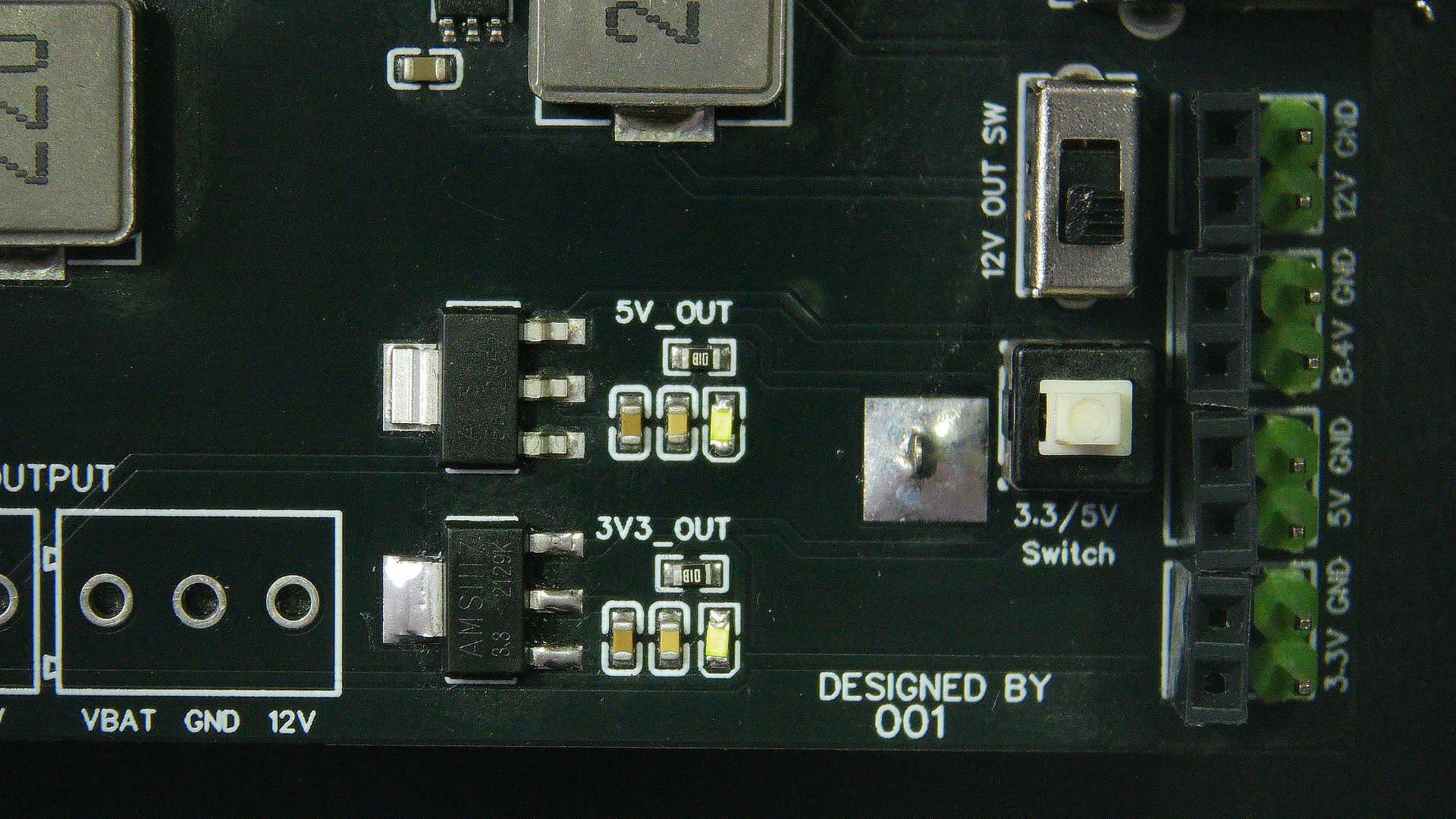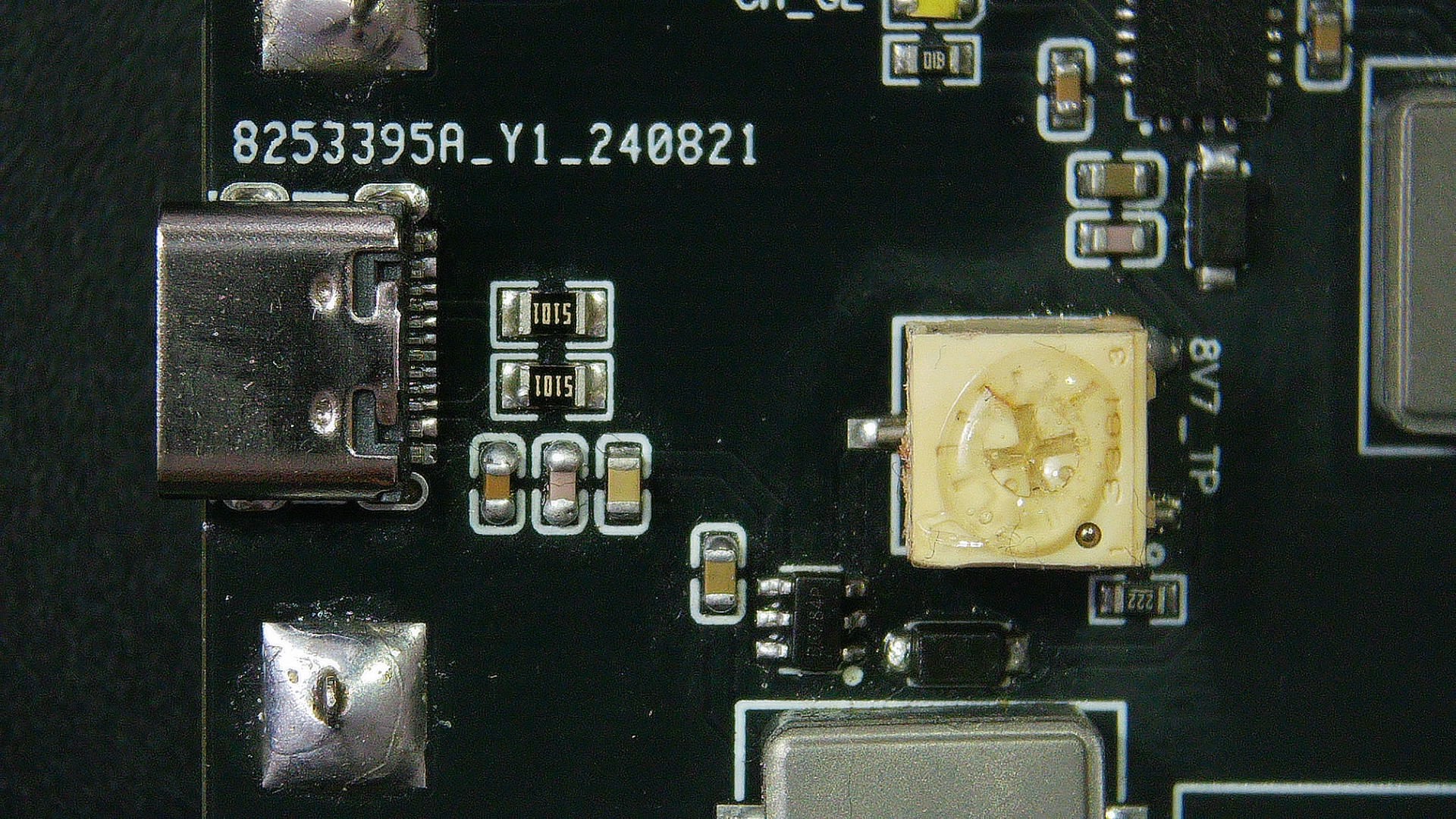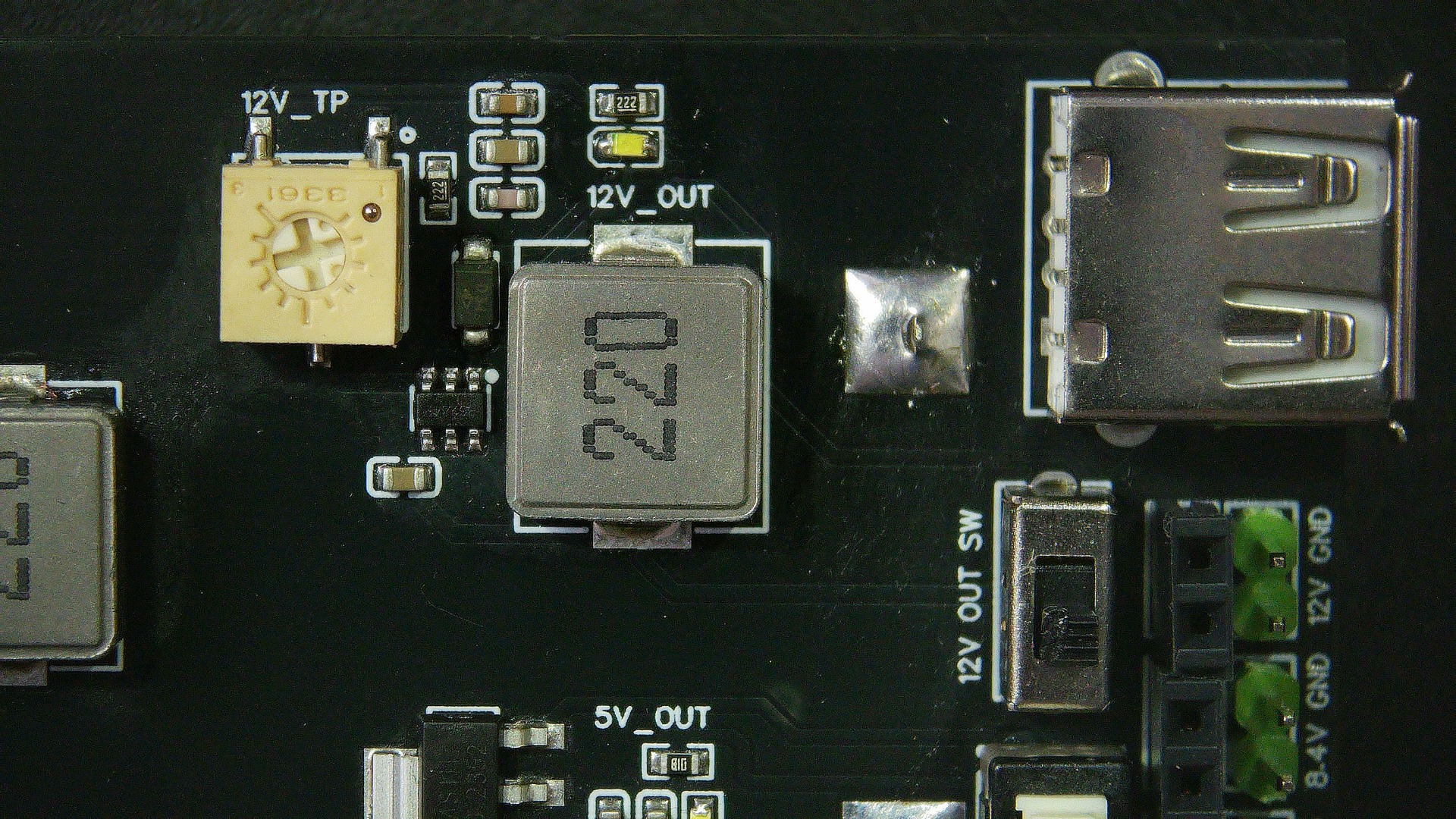DIY Portable Power Supply
Whenever I am travelling from one place to another, I used to keep my electronics with me. And sometimes to test even the simplest circuits made of few components multiple voltage levels, wires and USB voltages are required. I can not carry my bench power supply with me, that’s why previously I designed a modular portable power supply which is good to go with and has some voltage testing points. But as the circuit complexities increase it can not deliver that much power and overall I need a rigid easy to use power supply unit.
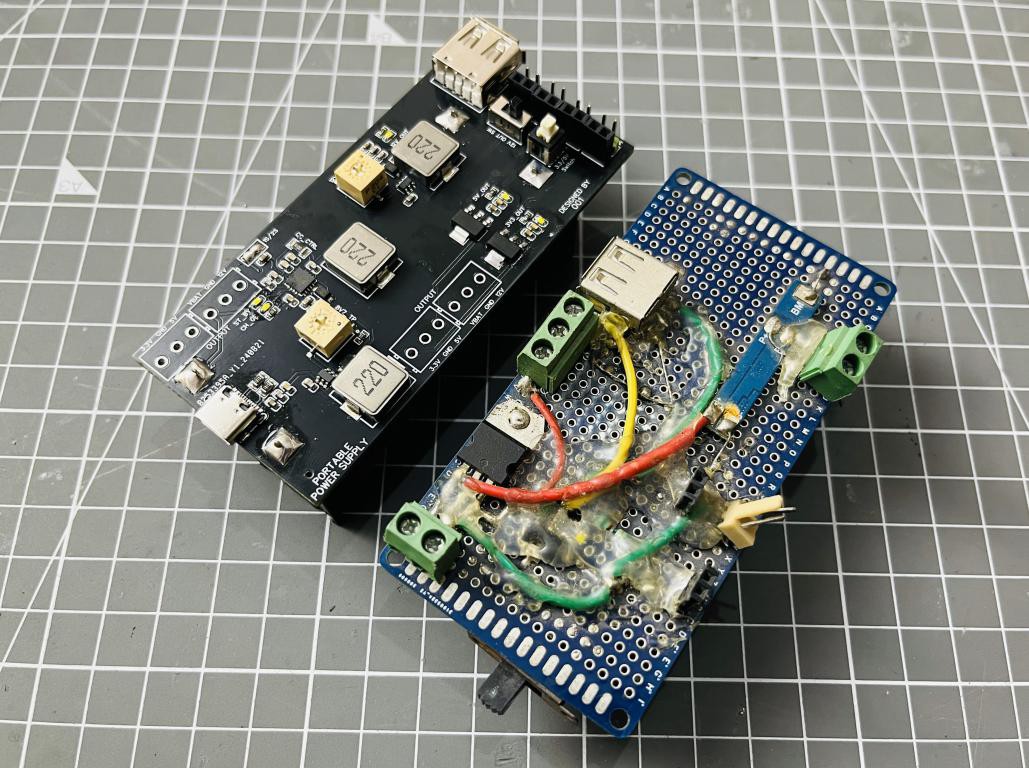
This is the newly designed portable power supply, I followed the 5v boosting approach in this design. So that I can charge the power supply anytime with a standard USB C/A charger. Overall the design is minimalist, looks good and carries 2S 18650 battery for the power backup. This project is sponsored by PCBWAY, China based PCB manufacturer having 10 years of experience in working with PCB related products. PCBWAY is a one stop solution to all your prototyping requirements including SMT assembly, Stencil, 3d printing and metal CNC.
Features:
5V input battery charging feature
Multiple output voltages 12V, 8.4V, 5V, 3.3V and USB
Boost Conversion at high frequency
Low noise and good PSRR
Switches for selecting output voltages
Onboard 8.4V two cell battery charger
Components Required:
- TP5100 2S battery charger
- MT3608 voltage booster
- AMS1117 3.3/5V regulator
- 10k Potentiometer for voltage select
- Some 0603 resistor (shown in schematics)
- 1nf, 10nf, 100nf, 1uf, 10uf, 22uf ceramic capacitors
- SMD LED 0603 white
- 22uH Inductor
- Push and slide switches
- USB type A/C Female, Screw terminals, Pin headers for I/O
- 18650 battery holder
- Circuit PCB from PCBWAY
Circuit Diagram and Design Approach:
The full circuit diagram can be seen below, the circuit is divided into small sections based on applications. I follow the top to down/ left to right approach, the input is placed on the top left and output at bottom right side.
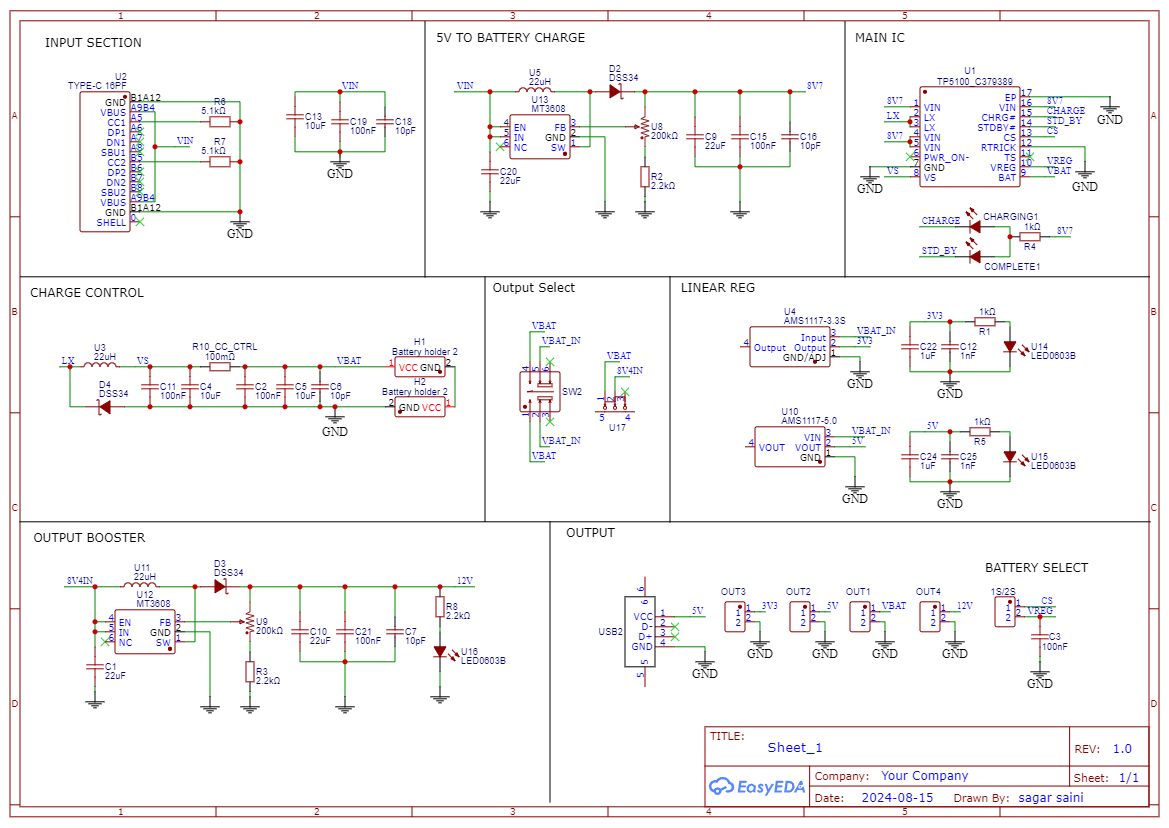
First section is the main type C input section which is used to charge the onboard 2s 18650 battery. The charging IC is placed in the middle (TP5100), 2S batteries need a max of 8.7V for battery charging. For this the voltage from the TYPE C USB is first boosted to 8.7 and then given to the battery charging unit. I used a 2S battery, two 4.2 batteries in series to get the stable 5V and 3.3V without any drop. In this way the full potential of the voltage regulators can be utilized. A 12V output voltage source is also required for other high voltage applications which is boosted from 8.7V from a second voltage booster section.
PCB Design Considerations:

Because it is a power supply board, it does not carry any differential pair or very high speed tracks across the PCB. Only a few boost conversion frequency generator small tracks which can be traced over a 2 layer stack-up easily keeping ground pour and returning paths in mind. I keep the input and output section away from each other. The 18650 2S battery is mounted on the bottom layer with battery holders.
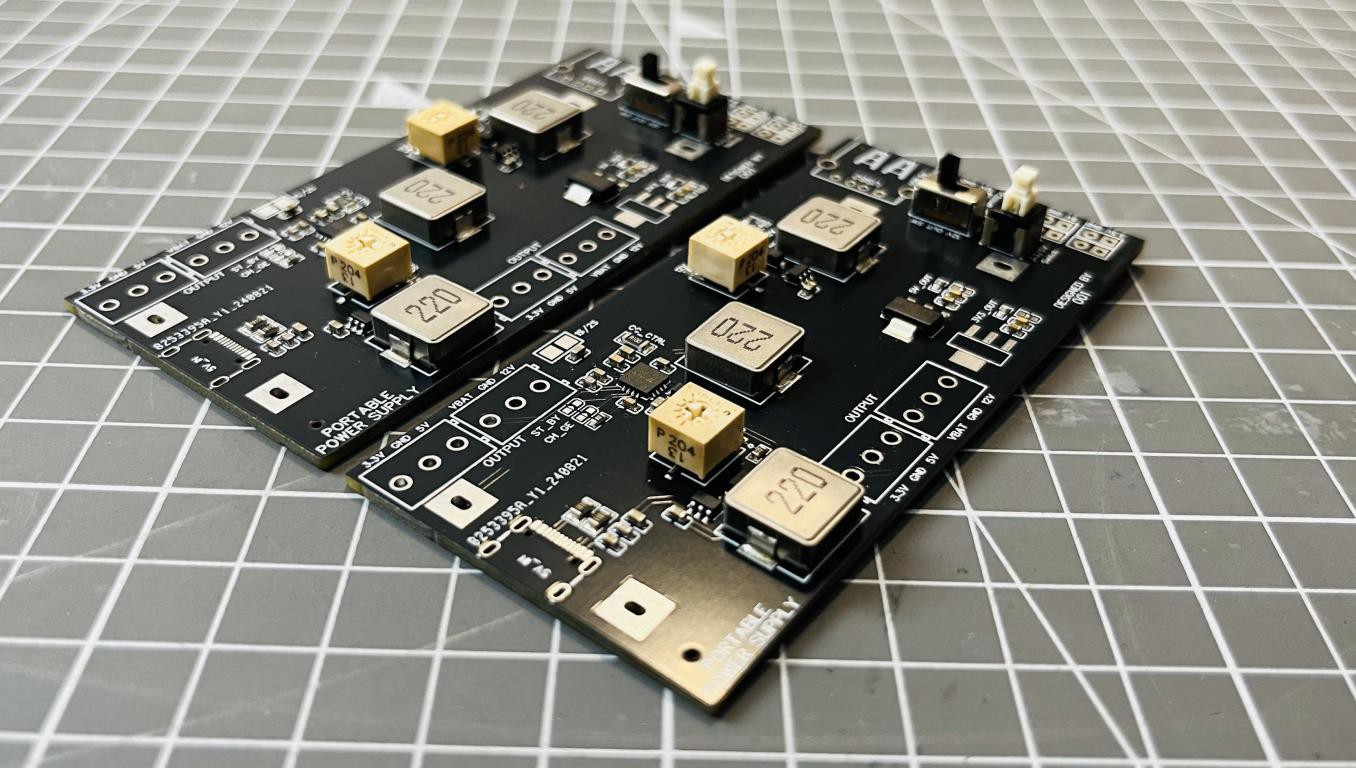
All the SMD parts are mounted on the top layer of the PCB. The booster section produces unwanted noise frequency, so keep this section away from the voltage regulator and battery charger section. High speed tracks are kept smaller and not overlapped with any other track. Avoid using via while routing for High speed frequency tracks. Ground pour is used on both sides, stitched together via through holes on the PCB. On the silkscreen you can find some test points to see the required voltages availability.
Assembly Process of PCB:
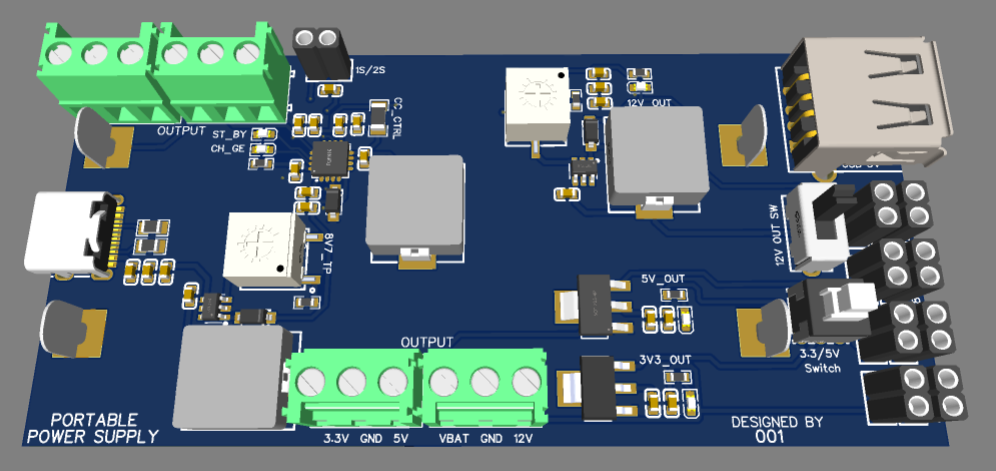
I used the PCBWAY SMT assembly process to get the soldering and part placement done easily. All the components are mounted on the top layer which lower down the overall cost. Some of the general parts are kept as DO NOT PLACE, and soldered by me after receiving the board.
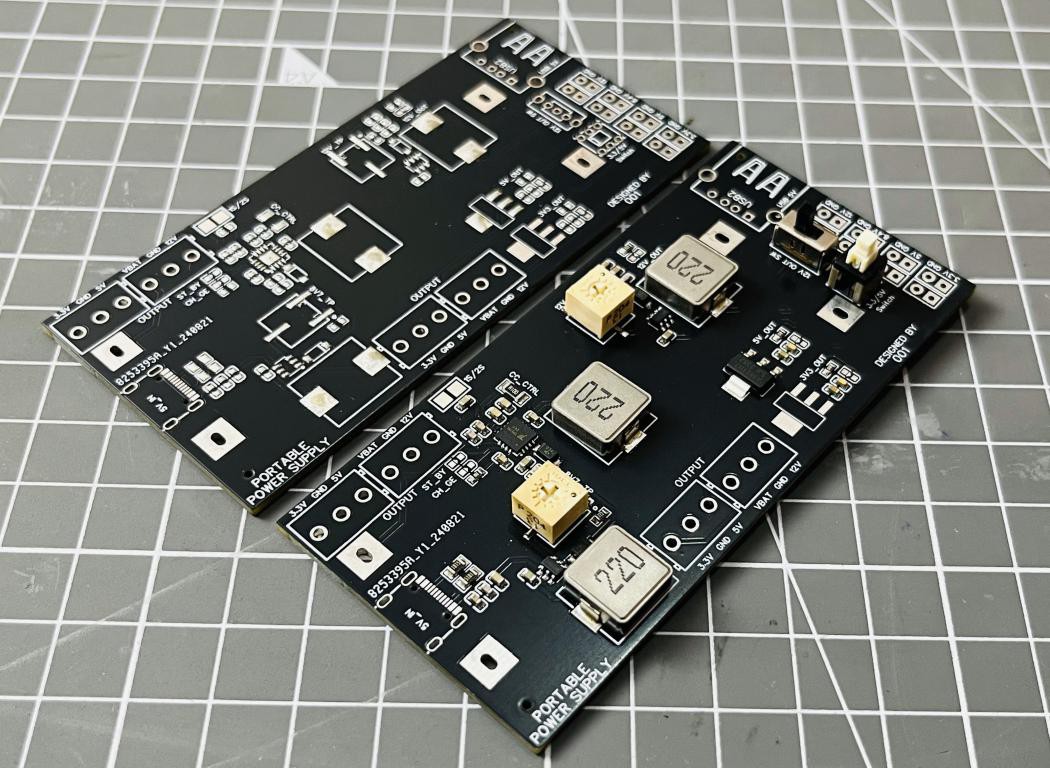
To lower down the cost you can solder the available parts yourself. Because the PCB has a lot of small components like resistor, ceramic capacitor, I opt to go with the assembly process.
First Power on and Working:
First time power on is not that simple, you can’t just plug the batteries in and use this supply. The PCB has onboard two potentiometers which need some adjustment while first time power on. Any wrong adjustments in these potentiometers may cause failure of IC and burn damages. Set the battery charger booster potentiometer to output a 8.5-8.7V. And 2nd 12V booster potentiometer to that voltage. This setting can be done by powering the portable battery supply with a low power input (max current 100mA) and this is only one time procedure.
After adjustments the batteries can be plugged into the holders, the onboard battery charger is working very fine, set to charge the batteries at a max of 1100mA. 5V, 3.3V has indicator led’s which can be controlled with a push button switch. An onboard slide switch is for 12V output and turns on the respective Led.
Further Design Improvements:
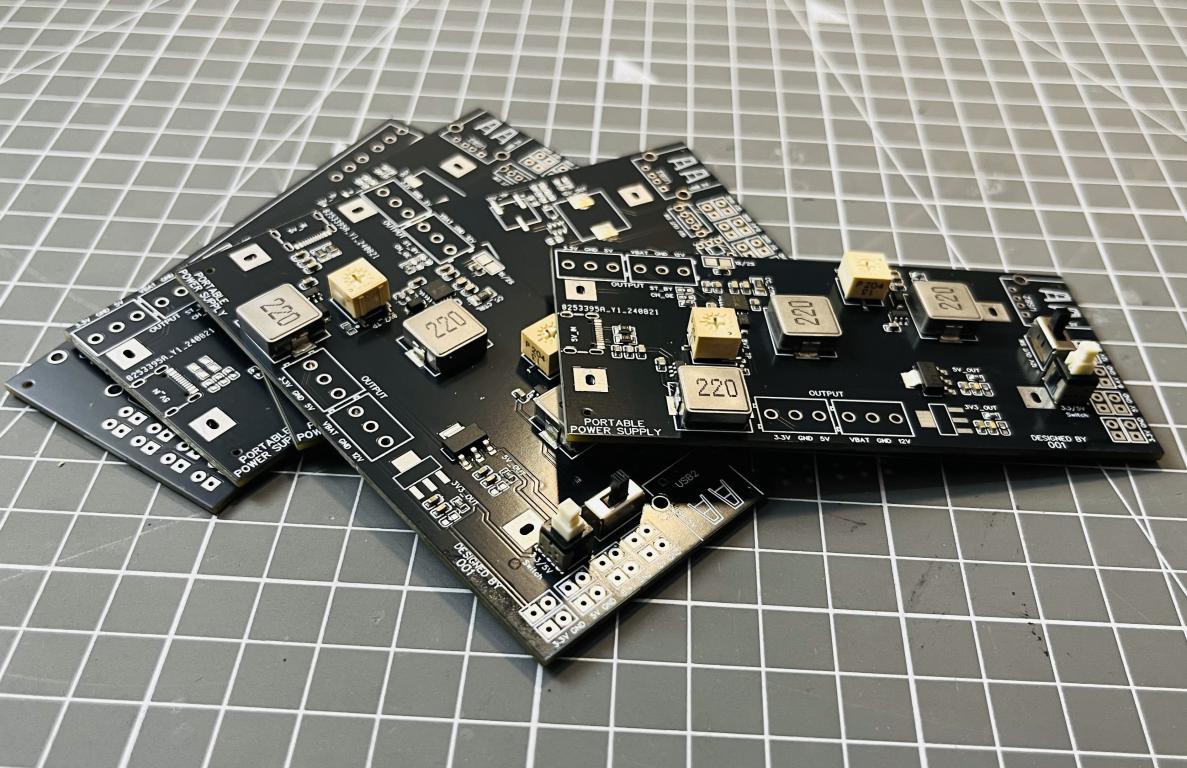
I want to keep the system minimal, but on the other hand I also want to monitor the real time voltages and current across each output port. Which can be displayed on a small OLED. But I don’t want such complexities in this hardware, so in the next update I will add a ESP8266 microcontroller which sends the current and voltage data on a server.
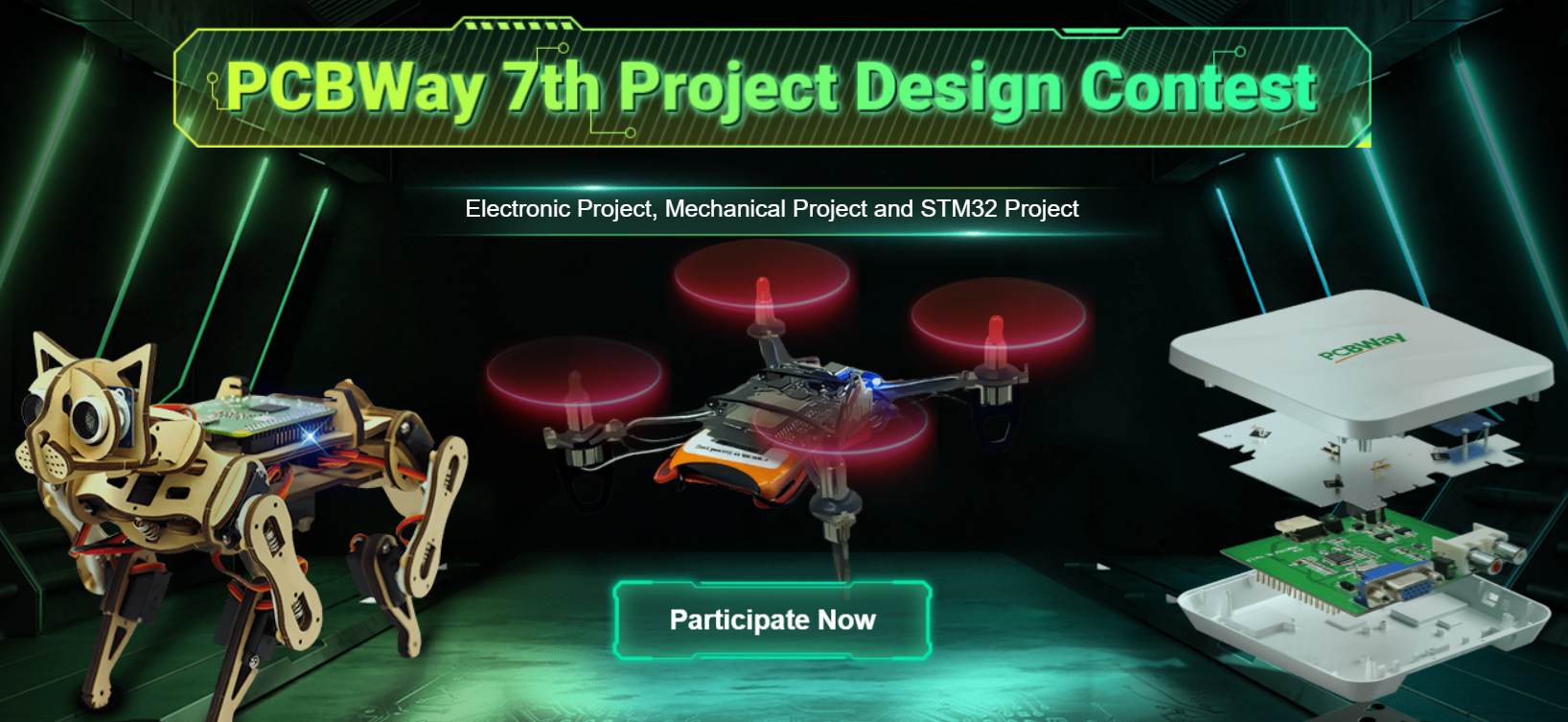
I am finding a solution to get the current values, for example hall effect sensor or maybe a simple shunt based one with a current amplifier. Try the best PCB services now and turn your dream projects into real world applications with PCBWAY. Explore the new PCB DESIGN CONTEST launched by PCBWAY recently.

DIY Portable Power Supply
*PCBWay community is a sharing platform. We are not responsible for any design issues and parameter issues (board thickness, surface finish, etc.) you choose.

Raspberry Pi 5 7 Inch Touch Screen IPS 1024x600 HD LCD HDMI-compatible Display for RPI 4B 3B+ OPI 5 AIDA64 PC Secondary Screen(Without Speaker)
BUY NOW
ESP32-S3 4.3inch Capacitive Touch Display Development Board, 800×480, 5-point Touch, 32-bit LX7 Dual-core Processor
BUY NOW
Raspberry Pi 5 7 Inch Touch Screen IPS 1024x600 HD LCD HDMI-compatible Display for RPI 4B 3B+ OPI 5 AIDA64 PC Secondary Screen(Without Speaker)
BUY NOW- Comments(0)
- Likes(1)
 Log in to post comments.
Log in to post comments.
-
 Josue Fernandez
Sep 25,2024
Josue Fernandez
Sep 25,2024
- 0 USER VOTES
- YOUR VOTE 0.00 0.00
- 1
- 2
- 3
- 4
- 5
- 6
- 7
- 8
- 9
- 10
- 1
- 2
- 3
- 4
- 5
- 6
- 7
- 8
- 9
- 10
- 1
- 2
- 3
- 4
- 5
- 6
- 7
- 8
- 9
- 10
- 1
- 2
- 3
- 4
- 5
- 6
- 7
- 8
- 9
- 10
 More by Manoj kumar
More by Manoj kumar
-
 Variable Current/Voltage DC power supply
To power up electronics circuits or while testing different voltage-ampere/power ranges are required...
Variable Current/Voltage DC power supply
To power up electronics circuits or while testing different voltage-ampere/power ranges are required...
-
 PCB soldering reflow hot Plate! A good Idea?
let’s talk about soldering in a new and easy method. Because I am working with SMT components and st...
PCB soldering reflow hot Plate! A good Idea?
let’s talk about soldering in a new and easy method. Because I am working with SMT components and st...
-
 Non-contact Infrared temperature sensor using Arduino
Hello guys, I want to make my own most accurate temperature meter. When coming to the high temperatu...
Non-contact Infrared temperature sensor using Arduino
Hello guys, I want to make my own most accurate temperature meter. When coming to the high temperatu...
-
 Arduino serial Programmer CH340N
There are lot of programmer boards that are compatible with Arduino. But the cheapest and smaller on...
Arduino serial Programmer CH340N
There are lot of programmer boards that are compatible with Arduino. But the cheapest and smaller on...
-
 My own Arduino Nano Microcontroller board
Here is my new Arduino Nano board, This looks better with C-type and one step above compatible drive...
My own Arduino Nano Microcontroller board
Here is my new Arduino Nano board, This looks better with C-type and one step above compatible drive...
-
 50Watts Audio Amplifier using TDA7265
Home theaters and speaker systems are very popular due to Bass songs, releasing everyday and I am ve...
50Watts Audio Amplifier using TDA7265
Home theaters and speaker systems are very popular due to Bass songs, releasing everyday and I am ve...
-
 STK4141 Amplifier is hidden GOLD
Analog audio amplifiers are very powerful enough to make a high noise with stable quality factor. I ...
STK4141 Amplifier is hidden GOLD
Analog audio amplifiers are very powerful enough to make a high noise with stable quality factor. I ...
-
 Solar Power MPPT Control Li-ion Battery Charger
When talking about standalone single cell battery chargers only one popular name came into my mind t...
Solar Power MPPT Control Li-ion Battery Charger
When talking about standalone single cell battery chargers only one popular name came into my mind t...
-
 AC Power Monitoring Using BL0937 IC
AC power monitoring is an amazing feature nowadays in IoT related applications, such as smart fans, ...
AC Power Monitoring Using BL0937 IC
AC power monitoring is an amazing feature nowadays in IoT related applications, such as smart fans, ...
-
 100W Lab Bench Power Supply From a Fast Charger
Power supplies play a very important role in testing electronic circuits. Power supplies are used to...
100W Lab Bench Power Supply From a Fast Charger
Power supplies play a very important role in testing electronic circuits. Power supplies are used to...
-
 MPPT Solar LIPO Battery Charger
I was just charging my Li-ion battery manually with my IP2312 charger, the high current version I ha...
MPPT Solar LIPO Battery Charger
I was just charging my Li-ion battery manually with my IP2312 charger, the high current version I ha...
-
 DIY Portable Power Supply
Whenever I am travelling from one place to another, I used to keep my electronics with me. And somet...
DIY Portable Power Supply
Whenever I am travelling from one place to another, I used to keep my electronics with me. And somet...
-
 I made a Nano USB HUB
I want to use the USB hub internally in my laptop but the available ones are very bulky and do not s...
I made a Nano USB HUB
I want to use the USB hub internally in my laptop but the available ones are very bulky and do not s...
-
 I made an ARDUINO NANO Clone Board
I made a series of Arduino Atmega328 boards and every new version has something new. We always learn...
I made an ARDUINO NANO Clone Board
I made a series of Arduino Atmega328 boards and every new version has something new. We always learn...
-
 Arduino Got Pro Max upgrade!!
I am aware of sensors, modules and integrated circuit used with microcontrollers like Arduino. And I...
Arduino Got Pro Max upgrade!!
I am aware of sensors, modules and integrated circuit used with microcontrollers like Arduino. And I...
-
 Minimal Component tester using Arduino
You might know component tester and its different versions made by many hobbyists. Today I have made...
Minimal Component tester using Arduino
You might know component tester and its different versions made by many hobbyists. Today I have made...
-
 Making a Digital Light Measuring Meter
While working on a home automation project on light, the light intensity unit- lux (lumens per squar...
Making a Digital Light Measuring Meter
While working on a home automation project on light, the light intensity unit- lux (lumens per squar...
-
 IR Jammer circuit using NE555 timer
I am working on IR protocol in university research Centre and then an idea of IR jammer comes into m...
IR Jammer circuit using NE555 timer
I am working on IR protocol in university research Centre and then an idea of IR jammer comes into m...
-
 Variable Current/Voltage DC power supply
To power up electronics circuits or while testing different voltage-ampere/power ranges are required...
Variable Current/Voltage DC power supply
To power up electronics circuits or while testing different voltage-ampere/power ranges are required...
-
 PCB soldering reflow hot Plate! A good Idea?
let’s talk about soldering in a new and easy method. Because I am working with SMT components and st...
PCB soldering reflow hot Plate! A good Idea?
let’s talk about soldering in a new and easy method. Because I am working with SMT components and st...
-
 Non-contact Infrared temperature sensor using Arduino
Hello guys, I want to make my own most accurate temperature meter. When coming to the high temperatu...
Non-contact Infrared temperature sensor using Arduino
Hello guys, I want to make my own most accurate temperature meter. When coming to the high temperatu...
-
 Arduino serial Programmer CH340N
There are lot of programmer boards that are compatible with Arduino. But the cheapest and smaller on...
Arduino serial Programmer CH340N
There are lot of programmer boards that are compatible with Arduino. But the cheapest and smaller on...
-
 My own Arduino Nano Microcontroller board
Here is my new Arduino Nano board, This looks better with C-type and one step above compatible drive...
My own Arduino Nano Microcontroller board
Here is my new Arduino Nano board, This looks better with C-type and one step above compatible drive...
-
 50Watts Audio Amplifier using TDA7265
Home theaters and speaker systems are very popular due to Bass songs, releasing everyday and I am ve...
50Watts Audio Amplifier using TDA7265
Home theaters and speaker systems are very popular due to Bass songs, releasing everyday and I am ve...
-
 STK4141 Amplifier is hidden GOLD
Analog audio amplifiers are very powerful enough to make a high noise with stable quality factor. I ...
STK4141 Amplifier is hidden GOLD
Analog audio amplifiers are very powerful enough to make a high noise with stable quality factor. I ...
-
 Solar Power MPPT Control Li-ion Battery Charger
When talking about standalone single cell battery chargers only one popular name came into my mind t...
Solar Power MPPT Control Li-ion Battery Charger
When talking about standalone single cell battery chargers only one popular name came into my mind t...
-
 AC Power Monitoring Using BL0937 IC
AC power monitoring is an amazing feature nowadays in IoT related applications, such as smart fans, ...
AC Power Monitoring Using BL0937 IC
AC power monitoring is an amazing feature nowadays in IoT related applications, such as smart fans, ...
-
 100W Lab Bench Power Supply From a Fast Charger
Power supplies play a very important role in testing electronic circuits. Power supplies are used to...
100W Lab Bench Power Supply From a Fast Charger
Power supplies play a very important role in testing electronic circuits. Power supplies are used to...
-
 MPPT Solar LIPO Battery Charger
I was just charging my Li-ion battery manually with my IP2312 charger, the high current version I ha...
MPPT Solar LIPO Battery Charger
I was just charging my Li-ion battery manually with my IP2312 charger, the high current version I ha...
-
 DIY Portable Power Supply
Whenever I am travelling from one place to another, I used to keep my electronics with me. And somet...
DIY Portable Power Supply
Whenever I am travelling from one place to another, I used to keep my electronics with me. And somet...
-
-
-
-
Modifying a Hotplate to a Reflow Solder Station
1012 1 6 -
MPL3115A2 Barometric Pressure, Altitude, and Temperature Sensor
546 0 1 -
-
Nintendo 64DD Replacement Shell
449 0 2 -
V2 Commodore AMIGA USB-C Power Sink Delivery High Efficiency Supply Triple Output 5V ±12V OLED display ATARI compatible shark 100W
1283 4 2 -
How to measure weight with Load Cell and HX711
768 0 3











